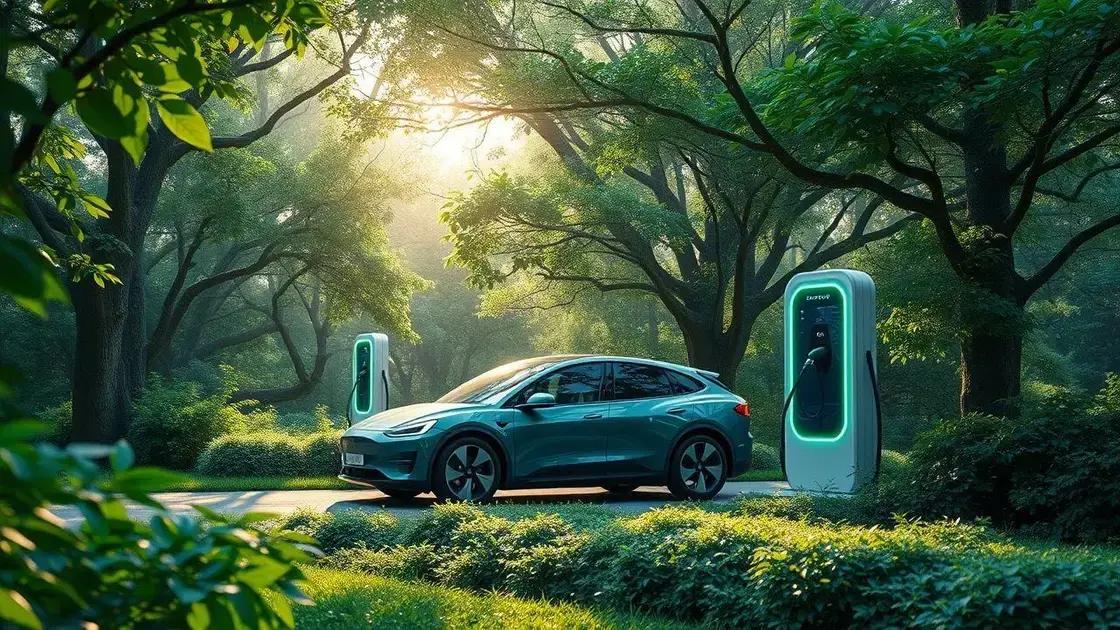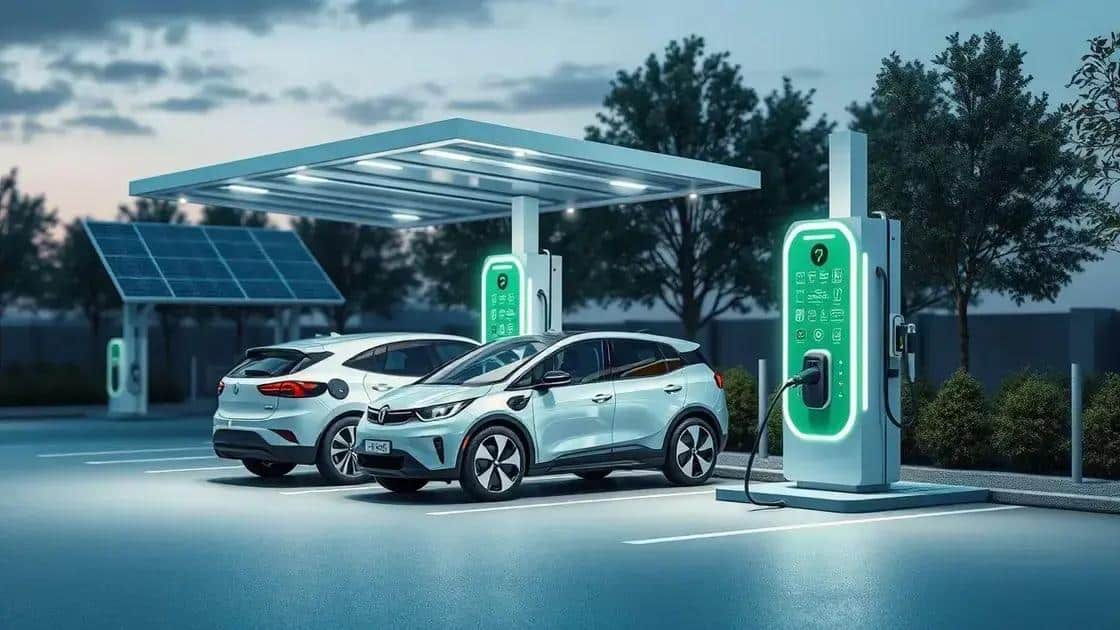Electric vehicle news trends: what you need to know

The future of charging infrastructure is essential for electric vehicle adoption, featuring expanded charging networks, smart technology, and stronger government support to enhance accessibility and efficiency for users.
Electric vehicle news trends are transforming how we think about transportation. With the rapid pace of innovation, understanding these trends can help you make informed decisions about your next vehicle.
Latest innovations in electric vehicles
The latest innovations in electric vehicles are paving the way for a cleaner and more efficient future. Technology is advancing rapidly, making these vehicles more accessible and appealing to consumers.
Battery Technology Improvements
One of the most exciting areas of innovation is battery technology. New developments are leading to longer-lasting batteries and faster charging times.
- Increased energy density
- Solid-state batteries
- Faster charging solutions
- Recycling advancements
These improvements are crucial for enhancing the overall electric vehicle experience.
Smart Features Integration
Another trend in electric vehicles is the incorporation of smart technology. This includes features such as advanced driver-assistance systems (ADAS) and connectivity options that improve safety and convenience.
For instance, many electric vehicles now come equipped with features that allow for seamless integration with smartphones. This makes it easier to monitor vehicle performance and manage charging.
Additionally, autonomous driving technology is making significant strides. As companies invest in research and development, we can expect to see more vehicles that can drive themselves with minimal human intervention.
Sustainable Manufacturing Practices
Electric vehicle manufacturers are also focusing on sustainability. They are exploring ways to reduce their environmental impact during production.
- Use of recycled materials
- Energy-efficient manufacturing processes
- Sourcing raw materials responsibly
This push for sustainability will help the automotive industry become more green.
As these innovations continue to unfold, the landscape of electric vehicles will evolve. Keeping an eye on these developments can provide valuable insights into the future of transportation.
Consumer preferences and trends

Understanding consumer preferences and trends in electric vehicles is vital for manufacturers and buyers alike. As electric vehicles (EVs) become more popular, the choices consumers make are shaping the market.
What Consumers Look For
Many factors influence consumer preferences. People are increasingly concerned about sustainability, which impacts their buying decisions. They want cars that are eco-friendly and align with their values.
- Environmental impact
- Cost of ownership
- Range anxiety
- Charging infrastructure availability
These factors play a significant role in how potential buyers evaluate their options.
Shift Towards Luxury and Tech Features
Another notable trend is the shift toward luxury and advanced technology. Consumers are looking for vehicles that not only perform well but also offer a premium experience.
Features like high-end materials, smart technology, and enhanced safety systems are increasingly important. Many buyers expect seamless integration of technology in their vehicles, such as advanced navigation and infotainment systems.
As electric vehicles evolve, companies need to focus on these trends to attract more customers.
The growth of online research plays a considerable role in the decision-making process. Most buyers now consult multiple sources, including social media and online reviews, before making a purchase.
By understanding consumer preferences and trends, manufacturers can adapt their offerings and marketing strategies effectively, ensuring they meet the evolving demands of the market.
Government policies affecting EV adoption
Government policies are crucial in shaping the landscape of electric vehicle (EV) adoption. Understanding how these regulations influence consumer behavior and manufacturer decisions is essential.
Incentives for Consumers
Many governments offer incentives to encourage the purchase of electric vehicles. These incentives can significantly reduce the overall cost for consumers, making EVs more appealing.
- Tax credits and rebates
- Grants for home charging installations
- Reduced registration fees
- Access to HOV lanes and other privileges
These programs aim to increase EV ownership and promote a cleaner environment.
Regulations on Emissions
Another key area is the regulation of emissions. Stricter emissions standards for traditional vehicles push manufacturers to develop and promote electric options. As a result, automakers are investing heavily in EV technology.
In many regions, governments plan to phase out gasoline and diesel vehicles completely. This transition aims to achieve cleaner air and reduce dependence on fossil fuels.
As manufacturers respond to these policies, consumers will see more affordable and diverse EV options in the market.
Support for Charging Infrastructure
Governments are also focusing on building charging infrastructure to support electric vehicle adoption. Expanding charging networks makes it easier for consumers to recharge their vehicles, reducing ‘range anxiety.’
- Installing fast chargers along highways
- Partnering with businesses for charging stations
- Investing in public charging solutions
As these initiatives grow, more people will feel confident in transitioning to electric vehicles.
In essence, government policies play a vital role in advancing the adoption of electric vehicles. By offering incentives, setting regulations, and building infrastructure, they create an environment that fosters a shift toward greener transportation.
The future of charging infrastructure

The future of charging infrastructure is crucial for the widespread adoption of electric vehicles (EVs). As more people choose EVs, having a solid infrastructure in place is essential.
Expansion of Charging Networks
One of the main goals for the future is to expand charging networks. This means an increased number of charging stations will be needed in both urban and rural areas.
- Fast charging options along highways
- Residential charging solutions
- Workplace charging facilities
- Public charging stations in shopping centers
Having accessible charging stations will greatly reduce any concerns about battery life during travels.
Smart Charging Technology
Smart charging technology is also on the rise. This technology allows for more efficient energy use. Charging stations will be able to communicate with vehicles and the grid to optimize charging times.
For example, during peak energy times, the system can delay charging until energy rates decrease. This will save consumers money and manage the overall energy load.
Moreover, integrating renewable energy sources with charging stations will further enhance sustainability. Solar panels and wind turbines can provide clean energy directly to the chargers.
Integration with Home Systems
Home charging stations are becoming smarter too. Many will have the capability to connect with home energy management systems. This integration allows users to monitor their energy use and select ideal charging times based on energy rates.
- Scheduling charges during off-peak hours
- Using energy from solar panels
- Remote monitoring via smartphone apps
This technology promotes a seamless experience for electric vehicle owners.
With these advancements, the charging infrastructure will play a major role in the growth and acceptance of electric vehicles. A well-developed charging system will help pave the way for a cleaner and more sustainable future.
In conclusion, the future of electric vehicles (EVs) looks promising thanks to various innovations and government policies. With advancements in charging infrastructure, consumers will enjoy improved accessibility and convenience. These changes, combined with smart technology and sustainable practices, are driving the shift towards greener transportation. As we progress, understanding these trends will help everyone—from manufacturers to consumers—make informed choices that benefit both the planet and their wallets.
FAQ – Frequently Asked Questions about Electric Vehicles and Charging Infrastructure
What are electric vehicles (EVs)?
Electric vehicles (EVs) are cars that are powered primarily by electricity instead of gasoline or diesel, leading to reduced emissions.
How does charging infrastructure affect EV adoption?
Robust charging infrastructure increases consumer confidence, making it easier for people to own and use electric vehicles.
What incentives are available for buying EVs?
Many governments offer incentives such as tax credits, rebates, and reduced fees to encourage the purchase of electric vehicles.
What is smart charging technology?
Smart charging technology allows charging stations to communicate with vehicles to optimize charging times, often saving money for EV owners.





